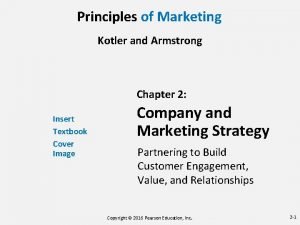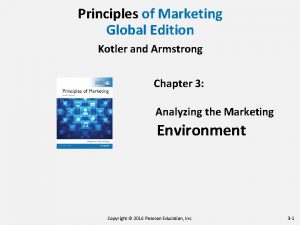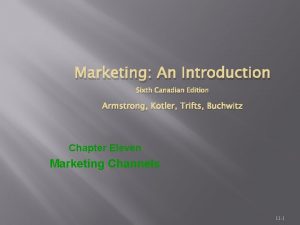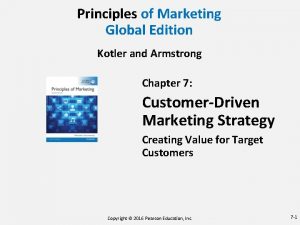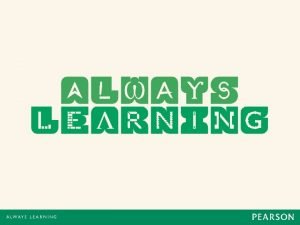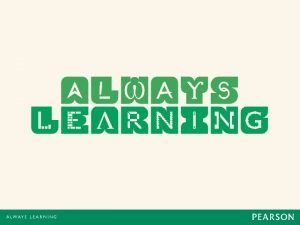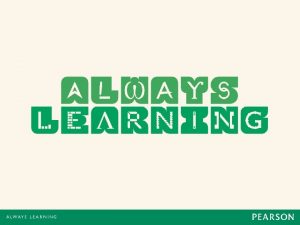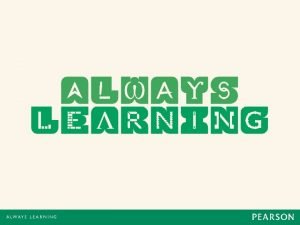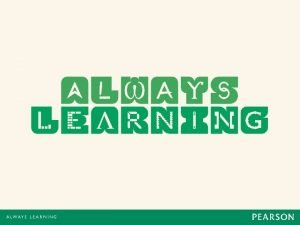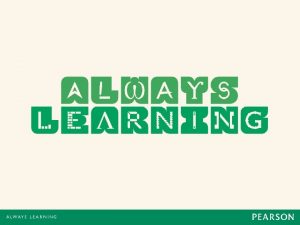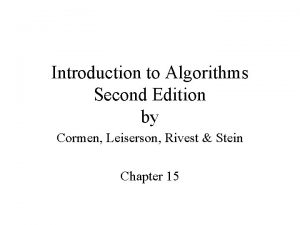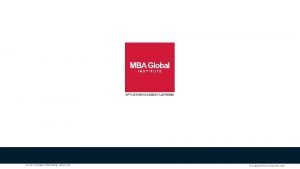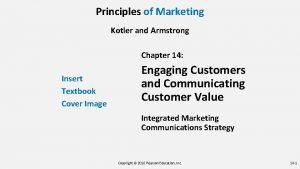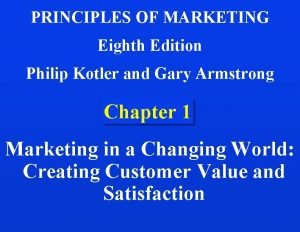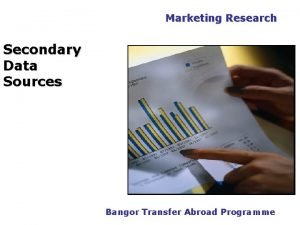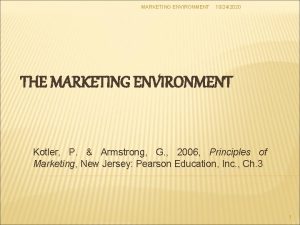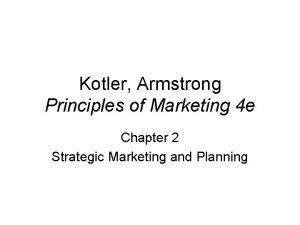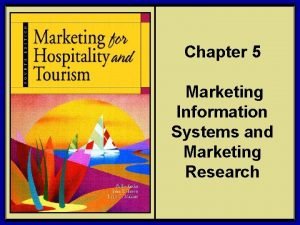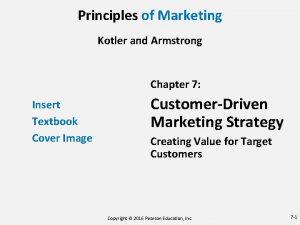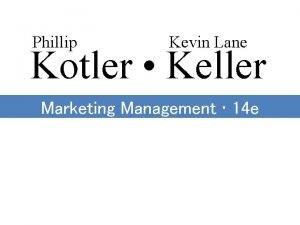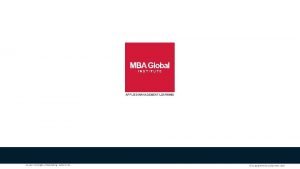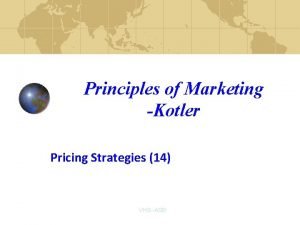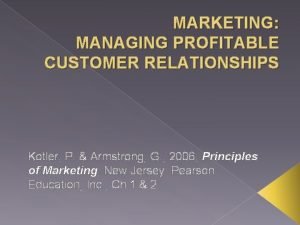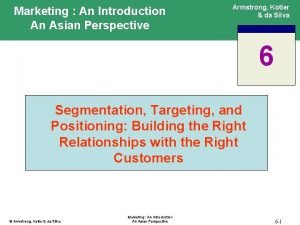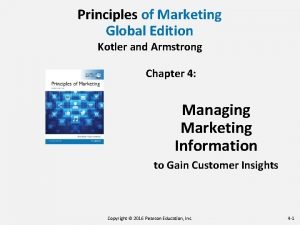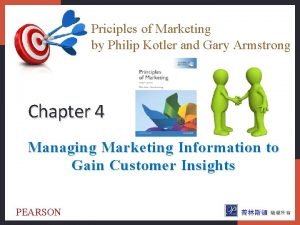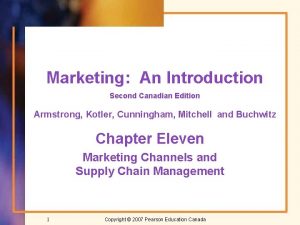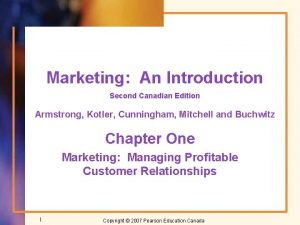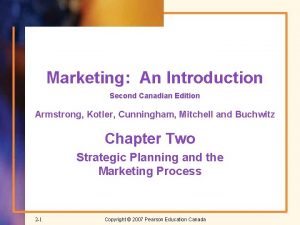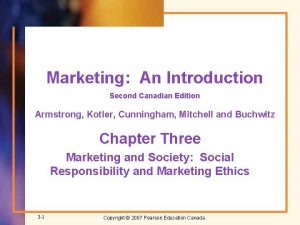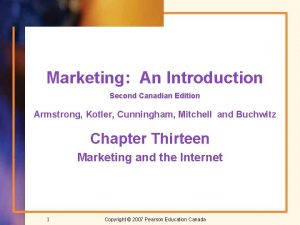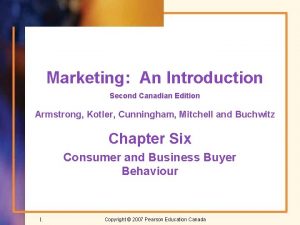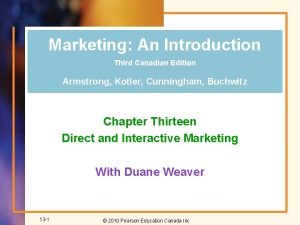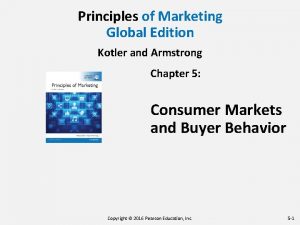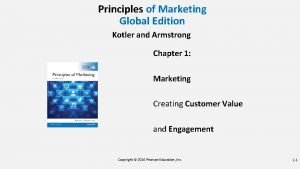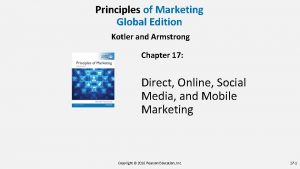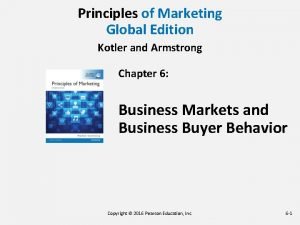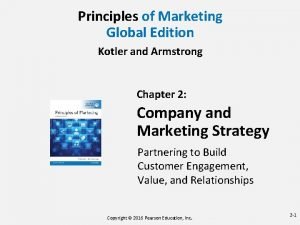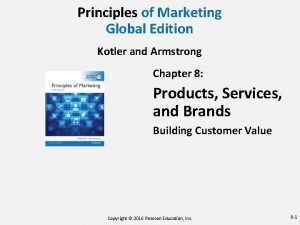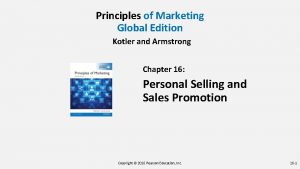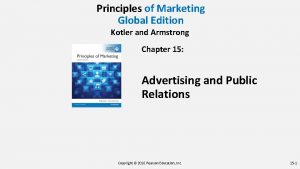Marketing An Introduction Second Canadian Edition Armstrong Kotler








































- Slides: 40

Marketing: An Introduction Second Canadian Edition Armstrong, Kotler, Cunningham, Mitchell and Buchwitz Chapter Twelve Integrated Marketing Communications 1 Copyright © 2007 Pearson Education Canada

Looking Ahead • Explain why it is important for organizations to integrate their marketing communications. • Describe and discuss the major decisions involved in developing an advertising program. • List the major marketing communications goals achieved through sales promotions. • List and describe the steps in the personal selling process. • Discuss the major forms of direct response marketing. • Explain how companies use public relations to communicate with their publics. 2 Copyright © 2007 Pearson Education Canada

Marketing Communications Mix • Advertising. – Any paid form of non-personal presentation and promotion of ideas, goods or services by an identified sponsor. • Sales Promotion. – Short-term incentives to encourage the purchase or sale of a product or service. 3 Copyright © 2007 Pearson Education Canada

Marketing Communications Mix • Public relations. – Building good relations with the company’s various publics by obtaining favorable publicity, building up a good corporate image and handling or heading off unfavourable rumors, stories and events. • Personal selling. – Personal presentation by the firm’s sales force for the purpose of making sales and building customer relationships. 4 Copyright © 2007 Pearson Education Canada

Marketing Communication Mix • Direct Marketing. – Direct connections with carefully targeted individual consumers to both obtain an immediate response and cultivate lasting customer relationships—the use of telephone, mail, fax, e-mail, the Internet and other tools to communicate directly with specific consumers. 5 Copyright © 2007 Pearson Education Canada

The Changing Environment • Two factors are changing the face of today’s marketing communications: – Vast improvements in information technology are speeding the movement toward segmented marketing – As mass markets have fragmented, marketers are shifting away from mass marketing. 6 Copyright © 2007 Pearson Education Canada

Integrated Communications • Response to fragmented mass markets and new technologies. • Allows promotions to be more targeted. • Integrated means “fits together. ” – Message is consistent across all channels. – Generate leverage through repetition and multiple sources with the same message. • Promotional mix must be coordinated with other marketing mix elements. 7 Copyright © 2007 Pearson Education Canada

The Need for IMC • Using IMC, the company carefully integrates and coordinates its many communication channels to deliver a clear, consistent and compelling message about the organization and its brands. 8 Copyright © 2007 Pearson Education Canada

Marketing Agencies • Nature of marketing agencies is changing. • Past habit was to have different agencies. working on different promotional elements. – Result was more ineffective than an IMC approach. • Today’s agencies are striving to provide IMC strategies and services. 9 Copyright © 2007 Pearson Education Canada

IMC Process • Managing the customer relationship over time. – Start with audit. – Assess the influence of each promotional tool on the target market at each stage of the buying process. – Blend all elements into an integrated mix. – Take into consideration product, distribution and price. 10 Copyright © 2007 Pearson Education Canada

Promotional Strategies • Push strategy: – Promotional effort to channel members to stock, promote products to consumers. – Personal selling and trade promotion-driven. • Pull strategy: – Promotional effort to appeal directly to consumers. – Advertising and sales promotion-driven. 11 Copyright © 2007 Pearson Education Canada

Setting the Advertising Budget • Affordable. – Based on what the company thinks it can afford. • Percentage-of-sales. – Based on a percentage of current or forecasted sales. • Competitive-parity. – Set budget to match competitors. • Objective-and-task. – Set objectives, determine tasks to achieve objectives, sum of task costs equals budget. 12 Copyright © 2007 Pearson Education Canada

Advertising • Reach large masses of geographically dispersed. • Allows for repetition and targeting of audience. • Builds awareness, image, positioning. • Provides wide artistic possibilities. • Can be expensive, impersonal, one-way. • Media fragmentation makes finding large audience difficult. 13 Copyright © 2007 Pearson Education Canada

Setting Advertising Objectives • An advertising objective is a specific communication task to be accomplished with a specific target audience during a specific period of time. • Classified by purpose: – Inform. – Persuade. – Compare. – Remind. 14 Copyright © 2007 Pearson Education Canada

Developing Advertising Strategy • Whether advertising should be an element in an IMC campaign. • If yes, then strategy consists of two major elements: – Creating advertising messages. – Selecting advertising media. 15 Copyright © 2007 Pearson Education Canada

The Message Strategy • Need a good message to communicate. • Break through advertising clutter. • Media proliferation has made attracting attention very difficult for advertisers. • Identify customer benefits related to product’s positioning. • Need a creative concept, or “big idea” to express that message. 16 Copyright © 2007 Pearson Education Canada

Message Execution • Typical approaches: – Slice of life. – Lifestyle. – Fantasy. – Mood or image. – Musical. – Personality symbol. 17 – Technical expertise. – Scientific evidence. – Testimonial evidence or endorsement. Copyright © 2007 Pearson Education Canada

Selecting Advertising Media • Reach. – Percentage of people exposed to ad. • Frequency. – Number of times a person is exposed to ad. • Media impact. – The qualitative value of a message exposure through a given medium. 18 Copyright © 2007 Pearson Education Canada

Choosing Media Type • Newspapers, magazines, television, radio, outdoors, direct mail, online. • Factors to consider: – – Media habits of target consumers. Nature of the product. Type of message. Cost. • Media vehicles-- specific media within each general media type. • Media timing – schedules, seasons, patterns. 19 Copyright © 2007 Pearson Education Canada

Evaluating Advertising • Ultimate test is whether sales have increased. • Measure before and after an ad campaign to measure results. • Online advertising the easiest to measure based on conversion rates and the ability to prompt immediate calls to action. 20 Copyright © 2007 Pearson Education Canada

International Advertising • Think globally, but act locally. • Consider language, cultural differences. • Media costs and availability can vary. 21 Copyright © 2007 Pearson Education Canada

Sales Promotion • • • Coupons, contests, premiums, incentives. Used to attract attention. Provide incentive for trial or purchase. Generates results now versus later. Effectiveness easier to track than advertising. • May detract from brand equity and loyalty. 22 Copyright © 2007 Pearson Education Canada

Sales Promotion Objectives • Consumer: increase short-term sales or help build long-term market share. • Trade: get retailers to: – carry new items and more inventory. – advertise products. – give products more shelf space. – buy ahead. 23 Copyright © 2007 Pearson Education Canada

Personal Selling • Personal, flexible, two-way communication, provides direct feedback. • Builds preference, conviction, action. • Suited to complex, higher priced products. • Basis for building a buyer relationship. • Most expensive on a per contact basis. • Requires long-term commitment and ongoing management. 24 Copyright © 2007 Pearson Education Canada

Sales Force Organization • Territorial – each person is assigned a geographic territory. • Product – salespeople specialize in selling a particular product. • Customer – salespeople specialize in selling to particular types of customers. • Outside – salespeople work in the field. • Inside – salespeople sell via phone or email. 25 Copyright © 2007 Pearson Education Canada

The Personal Selling Process • Prospecting. – Identify qualified potential customers. • Pre-approach. – Learn as much as possible about customer first. • Approach. – Meet the customer for the first time. • Presentation. – Tell the “product story” to the buyer, highlighting customer benefits. 26 Copyright © 2007 Pearson Education Canada

The Personal Selling Process • Handling objections. – Seek out, clarify and overcome customer objections to buying. • Closing. – The salesperson asks the customer for an order. • Follow-up. – The salesperson follows up after the sale to ensure customer satisfaction and repeat business. 27 Copyright © 2007 Pearson Education Canada

Direct Response • Direct connections with carefully targeted individual consumers. • Immediate and interactive. • Cultivate lasting customer relationships. • Can supplement to existing channels. • Fastest growing form of marketing. • Low-cost and efficient. 28 Copyright © 2007 Pearson Education Canada

Database Marketing • An organized collection of comprehensive data about individual customers or prospects, including geographic, demographic, psychographic and behavioural data. • Allows marketing messages to be finetuned to specific groups of people. 29 Copyright © 2007 Pearson Education Canada

Telemarketing • Using the telephone to connect directly. • Used in both consumer and B 2 B markets. • Can be outbound or inbound calls. • Used for both sales and customer service. 30 Copyright © 2007 Pearson Education Canada

Direct Mail Marketing • Involves sending an offer, announcement, reminder or other item to a person at a particular address. • Permits high target-market selectivity. • Personal and flexible. • Easy to measure results. 31 Copyright © 2007 Pearson Education Canada

Catalogue Marketing • Direct marketing through print, video or electronic catalogues that are mailed directly. • With the Internet, more and more catalogues going electronic. • Print catalogues still the primary medium. • Harder to attract new customers with Internet catalogues. 32 Copyright © 2007 Pearson Education Canada

Direct-Response TV Marketing • Television spots that persuasively describe a product and give customers a toll-free number for ordering. – Infomercials. – The Shopping Channel. – Kiosks. 33 Copyright © 2007 Pearson Education Canada

Public Policy and Ethics • Key issues include: – Misleading consumers including deception and fraud. – Taking advantage of impulse buyers, those addicted to TV and unsophisticated buyers. – Privacy and protection of personal information. – Invasion of privacy at home and the “do not call” registry. 34 Copyright © 2007 Pearson Education Canada

Public Relations • Public relations involves building good relations with the company’s various publics by obtaining favorable publicity, building up a good corporate image and handling or heading off unfavourable rumors, stories and events. 35 Copyright © 2007 Pearson Education Canada

Public Relations • News stories, features, press conferences, annual reports, corporate website. • Seen as more believable than advertising messages. • More cost efficient. • Can be difficult to control. • Can be proactive and reactive. 36 Copyright © 2007 Pearson Education Canada

Public Relations Functions • Press relations – get attention of media. • Product publicity – publicizing new products. • Public affairs – manage national or local community relations. • Lobbying – manage relations with legislators and officials. 37 Copyright © 2007 Pearson Education Canada

Public Relations Functions • Investor relations – manage relations with shareholders and financial community. • Development – fund raising for nonprofits. • Crisis management – manage reaction to sudden, bad publicity through problems with products, employees or the company. 38 Copyright © 2007 Pearson Education Canada

Public Relations Tools • • • News. • Audiovisual materials. Speeches. • Corporate identity Special events. materials. Buzz marketing. • Public service Mobile marketing. activities. Written materials. • Company website. 39 Copyright © 2007 Pearson Education Canada

Looking Back • Explain why it is important for organizations to integrate their marketing communications. • Describe and discuss the major decisions involved in developing an advertising program. • List the major marketing communications goals achieved through sales promotions. • List and describe the steps in the personal selling process. • Discuss the major forms of direct response marketing. • Explain how companies use public relations to communicate with their publics. 40 Copyright © 2007 Pearson Education Canada
 Marketing chapter 2
Marketing chapter 2 Kotler and armstrong principles of marketing
Kotler and armstrong principles of marketing Marketing an introduction 6th canadian edition
Marketing an introduction 6th canadian edition Accounting principles second canadian edition
Accounting principles second canadian edition Accounting principles second canadian edition
Accounting principles second canadian edition Accounting principles second canadian edition
Accounting principles second canadian edition Accounting principles second canadian edition
Accounting principles second canadian edition Customer driven marketing strategy
Customer driven marketing strategy Marketing management (arab world edition)
Marketing management (arab world edition) Marketing management (arab world edition) philip kotler
Marketing management (arab world edition) philip kotler Marketing management (arab world edition) philip kotler
Marketing management (arab world edition) philip kotler What are the keys to effective internal marketing
What are the keys to effective internal marketing Kotler e keller
Kotler e keller Marketing management (arab world edition) philip kotler
Marketing management (arab world edition) philip kotler Introduction to algorithms 2nd edition
Introduction to algorithms 2nd edition Fundamentals of corporate finance, third canadian edition
Fundamentals of corporate finance, third canadian edition Fundamentals of corporate finance third canadian edition
Fundamentals of corporate finance third canadian edition Kotler et al 2017
Kotler et al 2017 14 principles of marketing
14 principles of marketing Principles of marketing management by philip kotler
Principles of marketing management by philip kotler Marketing information system kotler
Marketing information system kotler Marketing information system kotler
Marketing information system kotler Marketing research process kotler
Marketing research process kotler New consumer capabilities
New consumer capabilities Analytical marketing system
Analytical marketing system Philip kotler marketing environment
Philip kotler marketing environment Marketing plan steps kotler
Marketing plan steps kotler Marketing information systems and marketing research
Marketing information systems and marketing research Principles of marketing philip kotler ppt
Principles of marketing philip kotler ppt Kotler definition of marketing
Kotler definition of marketing Brand positioning kotler
Brand positioning kotler Market segmentation kotler
Market segmentation kotler Marketing kotler
Marketing kotler Kotler's pricing strategy
Kotler's pricing strategy Marketing kotler
Marketing kotler Armstrong
Armstrong Administração de marketing kotler e keller
Administração de marketing kotler e keller Marketing research process kotler
Marketing research process kotler Priciples of marketing
Priciples of marketing 27 miles per gallon into kilometers per liter
27 miles per gallon into kilometers per liter Advanced word power second edition answers
Advanced word power second edition answers
